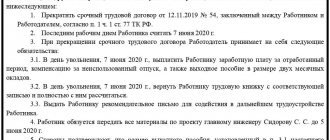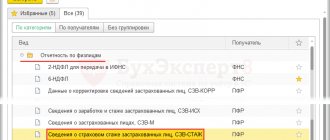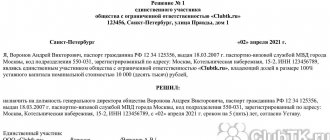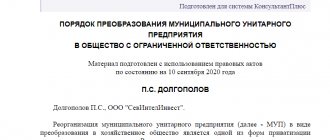What it is?
Transformation is a special type of reorganization, which is a change in the organizational and legal form of a company, while another legal entity is created, and the old one ceases its activities, the constituent documents and charter are changed, but all rights and obligations are retained after the procedure.
A significant difference from other types of reorganization, that is, merger, separation, accession, is that one legal entity begins to participate in the procedure and, as a result, one company is also formed .
The process has some features:
- From an economic point of view, the transformed organization is one and the same company, which has only changed its management structure and legal status, and no changes have occurred in other areas of the company’s life.
- From a macroeconomic point of view, such a reorganization is a neutral action in relation to capital, since there is no division or merger of the authorized capital of several companies. This nuance is the most significant difference. In other cases, assets and liabilities are either combined into one fund or divided among several organizations.
- From a legal point of view, during the transformation, a completely new enterprise is created, which is a complete successor to the obligations and rights of its predecessor. The book value of the property does not change.
There are two types of transformation:
- Voluntary . Carried out only on the initiative of the company owners. For example, the procedure can be carried out if the owners or founders come to the conclusion that the enterprise will operate most effectively in a different legal form. Most often, for this reason, an LLC is transformed into a joint stock company.
- Mandatory . It is carried out upon the occurrence of certain circumstances defined by law. There are several such cases: participants in a non-profit organization intend to conduct business, and it is transformed into a partnership or society;
- the number of participants in an LLC or CJSC exceeds 50 people, and it is necessary to reorganize the enterprise into an OJSC or cooperative.
Reorganization does not include a change in the type of joint stock company, for example, a transition from an OJSC to a CJSC. This action is recorded as a name change.
Regulation by law
The most important documents regulating the procedure are:
- Civil Code of the Russian Federation. The main types of reorganization, definitions, and features are established by Article 57 of the Civil Code of the Russian Federation.
- Federal Law No. 129-FZ of August 8, 2001 “On state registration of legal entities and individual entrepreneurs.” The procedure, necessary documents, nuances are indicated in Chapter V.
Other regulations establish some restrictions on the choice of legal form into which an existing enterprise can be transformed:
- LLC - into a partnership, a company of another type, a cooperative;
- private institution - to a foundation, non-profit organization, society;
- production cooperative - into a partnership, society;
- CJSC and OJSC - into LLC, non-profit partnership, cooperative.
When determining a new form, it is worth taking into account the requirements established by law for the amount of capital, the number of founders, etc.:
- A company cannot have one legal entity as its founder, which also has a single owner.
- The founder of a partnership must be registered as an individual entrepreneur if he is an individual.
- Minimum size of the capital: LLCs and CJSCs owe more than 10 thousand rubles;
- For OJSC this amount is equal to 100 thousand rubles.
- for partnerships - 2 or more;
Reorganization in the form of transformation
“Transformation” means the reorganization of a legal entity, as a result of which a new legal entity with a different organizational and legal form arises.
In this case, the reorganized entities cease to exist, and all the rights and obligations of the reorganized entity are transferred to the newly created legal entity in accordance with the transfer deed. The law establishes restrictions on transformation through the selection of new forms of legal entity. Thus, an LLC can be transformed into a business company of another type, a business partnership or a production cooperative. Joint stock company - LLC, cooperative, non-profit partnership. Autonomous non-profit organization - to the fund.
Reorganization in the form of transformation consists of changing the organizational and legal form of a legal entity, for example, transforming a limited liability company (LLC) into a closed joint-stock company (CJSC). Reorganization in the form of transformation is carried out by decision of its founders (participants) or a body of a legal entity authorized to do so by the constituent documents. Reorganization of a person entails the emergence of succession (even without being associated with the termination of its activities in the case of separation or in the absence of a new legal entity in cases of merger or transformation).
Reorganization is the termination of the activities of one legal entity and the emergence of another on its basis. The law allows for the possibility of using transformation to change the status and forms of a legal entity by transforming a commercial organization into a non-profit organization and vice versa.
Reorganization and transformation contain mandatory requirements for founders, name, and authorized capital. In particular, the minimum authorized capital of LLCs and CJSCs is 10 thousand rubles, and for OJSCs it is 100 thousand rubles. Various types of companies (LLC, CJSC, OJSC) cannot have a single founder - a legal entity, which in turn consists of one founder.
If you have any questions, consult a leading arbitration lawyer for FREE.
Step-by-step registration instructions
The procedure occurs in several stages in a certain order. Actions of the founders:
- Making a decision on reorganization . At the general meeting of all owners of the enterprise, the following issues are discussed: conditions of transformation;
- exchange of shares of participants or contributions to the authorized capital of a future enterprise;
- the charter of the new organization is agreed upon.
- receive creditors' claims for repayment of obligations, draw up a register of counterparties, amounts payable, etc.;
draw up and sign reconciliation reports with partners;
Based on this data, the founders draw up and approve the transfer deed. The absence of a document is the reason for refusal of state registration of the reorganization. The act states:
- general information about the enterprise;
- income statement;
- gear balance;
- explanations.
After all these documents are completed, they are submitted for state registration.
- deregister with the tax office, the statistics body, and extra-budgetary funds;
You can find out more detailed information about the stages of the procedure in the following video:
Changing CJSC to LLC
According to paragraph 1 of Article 57 of the Civil Code, the reorganization of a legal entity can be carried out by decision of its founders (participants) or a body of the legal entity authorized to do so by the constituent documents. This postulate also applies to a joint stock company planning to transform into a limited liability company.
As follows from paragraph 2 of Article 20 of Law No. 208-FZ, a proposal for such a reorganization is made by the board of directors or the supervisory board of the company. This issue is resolved by the general meeting of shareholders of the reorganized joint stock company. In this case, the final decision must contain the following information:
- name, information about the location of the new legal entity created through the reorganization of the company in the form of transformation;
- procedure and conditions of transformation;
- the procedure for exchanging shares of the company for shares of participants in the authorized capital of the LLC;
- instructions on approval of the transfer act with the attachment of the transfer act;
- an instruction on approval of the constituent documents of the legal entity being created with the attachment of the constituent documents.
In addition, the decision must record data on the list of members of the audit commission, collegial executive body, sole executive body or other body in cases where the creation of such a structure is provided for by the charter and law, and its formation is within the competence of the highest management body of the legal entity being created.
Once the decision has been made, the JSC is obliged to notify the tax authority in writing about the start of the reorganization procedure within three days.
The form of the message is presented in the letter of the Federal Tax Service of Russia dated January 23, 2009 No. MN-22-6/64. It must be accompanied by a formalized decision on reorganization. During the same period, it is necessary to notify the Pension Fund and the Social Insurance Fund in writing (clause 3, part 3, article 28 of the Federal Law of July 24, 2009 No. 212-FZ).
Based on paragraph 11 of Article 89 of the Tax Code, in connection with the reorganization, the company may be subject to an on-site tax audit.
Moreover, this audit can be carried out regardless of the time and subject of the previous audit. However, the standard rule that a period of no more than three previous calendar years can be checked remains true in this situation.
In any case, within the next three days after receiving the notification, the tax authorities will enter information that the legal entity is in the process of reorganization into the Unified State Register of Legal Entities. After this, the reorganized joint stock company is obliged to publish a message about its reorganization in the journal “Bulletin of State Registration” twice, with a difference of a month.
Such a message, in accordance with the requirements of paragraph 6.1 of Article 15 of Law No. 208-FZ, must contain the following information:
- full and abbreviated names, information about the location of each company participating in the reorganization;
- full and abbreviated names, information about the location of each company created (continuing activities) as a result of the reorganization;
- form of reorganization;
- a description of the procedure and conditions for the creditors of each legal entity participating in the reorganization to submit their claims, including an indication of the location of the permanent executive body of the legal entity, additional addresses to which such claims can be submitted, as well as methods of communication with the reorganized company (telephone numbers, faxes, email addresses and other information);
- information about persons performing the functions of the sole executive body of each legal entity participating in the reorganization, as well as legal entities created (continuing activities) as a result of the reorganization;
- information about persons intending to provide security to creditors of the reorganized company, as well as about the conditions for securing the fulfillment of obligations under the obligations of the reorganized company (if there are such persons).
Another requirement is that within five working days after sending the notice of the start of the reorganization, notify in writing, indicating (at least) the above information, all known creditors (clause 2 of article 13.1 of Law No. 129-FZ of August 8, 2001 “On state registration of legal entities and individual entrepreneurs").
Only if there is evidence of notification to creditors, the registering authority will make appropriate entries in the register on the creation of a new company and on the termination of the activities of the old one (Clause 6, Article 15 of Law No. 208-FZ).
Registration of a new legal entity created through reorganization is carried out on the basis of an application in form No. P12001, recommended in the letter of the Federal Tax Service of Russia dated June 25, 2009 No. MN-22-6 / [email protected]
The following package of documents must be submitted along with the application:
- constituent documents of a new legal entity created through reorganization in the form of transformation in two copies;
- decision of the general meeting (or the sole participant/shareholder) on the transformation of the enterprise;
- a transfer act containing information about the legal succession of the new company for absolutely all existing (including disputed) obligations of the reorganized company;
- a receipt for payment of state duty in the amount of 4 thousand rubles;
- evidence of the transfer of information to the Pension Fund if its submission is required by law;
- evidence of sending letters notifying creditors of the reorganization in the form of transformation.
In the process of transforming a joint stock company into a limited liability company, the shares of the joint-stock company are exchanged for shares in the authorized capital of the LLC. The shares will then be cancelled.
On the day of filing documents for registration of a new company, this fact must be reported to the registrar who maintains the register of owners of securities of the joint stock company ending its activities. This is done on behalf of the JSC.
Upon making the corresponding entry in the Unified State Register of Legal Entities, namely on the same day, this information must be duplicated in a message sent to the registrar by the created limited liability company (clause 8.3.7 of the Standards for the issuance of securities and registration of securities prospectuses”, approved by the Order of the Federal Financial Markets Service of the Russian Federation dated January 25, 2007 No. 07-4/pz-n (as amended on July 20, 2010)).
On the same day, that is, from the moment of state registration of the new legal entity, the reorganization is considered completed.
Required documents
The legislation establishes a list of documentation required for submission to the tax service. To register the transformation, the following documents of the liquidated enterprise must be submitted:
- Application on form P12001. The document must be signed by the applicant. Provided for each emerging company.
- A set of documents of the reorganized organization. It includes:
- TIN;
- charter;
- extract from the Unified State Register of Legal Entities;
- OGRN certificate.
statistics codes;
Originals or notarized copies are submitted to the Federal Tax Service. Documents are provided in two copies.
For a newly created company, the following information is needed:
- full and abbreviated name;
- activity codes;
- legal address;
- size of the authorized capital indicating the form of payment;
- details of the manager, name of his position;
- data of the chief accountant;
- data of the founders indicating their shares in the authorized capital;
- information about the bank in which the account will be opened;
- The contact person.
If these documents and information are available, the tax authorities register the reorganization of the enterprise.
Algorithm
Reorganization in the form of merger is a multi-stage process. In general, it can be divided into the following stages:
- Making an unambiguous decision by the owners (founders). If there are several of them, then minutes of the general meeting are prepared for documentary confirmation. If there is one, then it is formalized in the form of a decision.
- Drawing up an agreement with the successor organization.
- Issuance of the corresponding order.
- Notification of the organization's employees in advance, in writing. This is necessary for productive interaction with employment services.
- Within a three-day period after the order is issued, notifications (with confirmation of receipt) are sent to the registration authorities. If necessary, extra-budgetary funds of the joining company are notified.
- Counterparties are notified.
- There should be a publication about the reorganization in the media - the specialized publication “Bulletin of State Registration”. Moreover, posting a fresh note once is not enough. It must be published twice. This is the only way an organization can prove that it has no desire to hide any facts from contractors or third parties.
- An inventory of the company's movable and immovable property is carried out. Inventory acts are drawn up.
- A transfer deed is drawn up and attached to the contract.
- Amendments to the Charter.
- Consolidate changes in the state register, tax and other organizations that control the company’s activities.
If everything is in order with the paperwork, then employees of the state registry are required to enter the relevant information into the general database within three working days. Without a transfer act during reorganization in the form of a merger, this entire mechanism is simply impossible.
Does the TIN change?
From a legal point of view, during reorganization, the enterprise ceases to exist and a completely new company is created. In this regard, all company details are changing.
During the procedure, the taxpayer number of the converted company is removed from the register. In the future, this TIN will no longer be used. The newly created enterprise is assigned a different number .
If the legal form changes without reorganization, the TIN remains the same. For example, when an OJSC is transferred to a CJSC, no changes are made in the tax service register.
Other nuances
Conversion is a rather complex procedure. There are a few more nuances, knowledge of which will allow you to carry it out without violations:
- The liquidated enterprise must draw up final financial statements as of the date preceding the day the reorganization was recorded.
- The new organization must provide introductory reports. It is compiled by transferring indicators from the final one.
- If an enterprise used a special tax regime, then after reorganization it can apply the simplified tax system or UTII only if it submits an application to the tax authorities.
- Small organizations wishing to switch to the simplified tax system or UTII can submit a corresponding application within five days from the date of creation.
- The duration of the procedure is approximately 2-3 months .
- To implement this, you can use the services of specialized companies.




